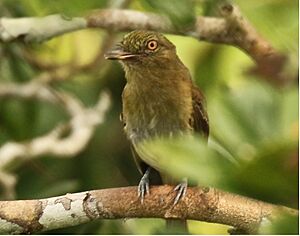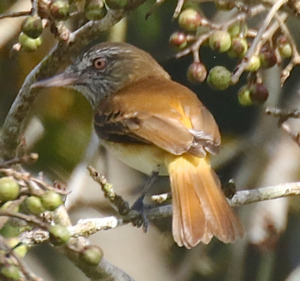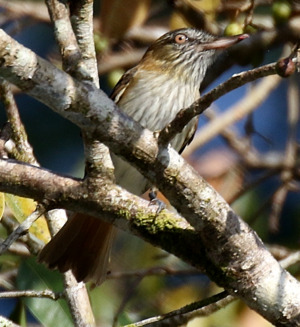Bright-rumped attila facts for kids
Quick facts for kids Bright-rumped attila |
|
|---|---|
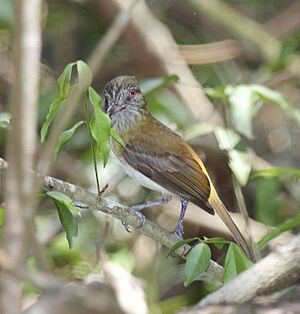 |
|
| Conservation status | |
| Scientific classification | |
| Genus: |
Attila
|
| Species: |
spadiceus
|
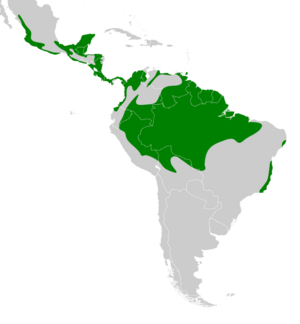 |
|
The bright-rumped attila (also called the polymorphic attila) is a small bird known for its bright yellow rump. It belongs to the tyrant flycatcher family. This bird lives in many places, from northwestern Mexico all the way to western Ecuador, Bolivia, and southeastern Brazil. You can also find it on the island of Trinidad.
Contents
About the Bright-Rumped Attila's Name
The bright-rumped attila was first officially described in 1789 by a German scientist named Johann Friedrich Gmelin. He gave it the scientific name Muscicapa spadicea. The word spadiceus comes from Latin and means "chestnut-colored" or "date-colored."
Later, in 1831, a French scientist named René Lesson created a new group of birds called Attila. The bright-rumped attila is now one of seven flycatchers in this group.
Different Types of Bright-Rumped Attilas
There are twelve different types, or subspecies, of the bright-rumped attila. They are found in various parts of its wide range:
- A. s. pacificus – found in northwest Mexico
- A. s. cozumelae – found on Cozumel island in Mexico
- A. s. gaumeri – found in the Yucatán Peninsula and nearby islands
- A. s. flammulatus – found from southeast Mexico to Belize and central north Honduras
- A. s. salvadorensis – found from El Salvador to northwest Nicaragua
- A. s. citreopyga – found from southeast Honduras and Nicaragua to west Panama
- A. s. sclateri – found in east Panama and northwest Colombia
- A. s. caniceps – found in north and central north Colombia
- A. s. parvirostris – found in northeast Colombia and northwest Venezuela
- A. s. parambae – found in west Colombia and northwest Ecuador
- A. s. spadiceus – found from east Colombia through Venezuela and the Guianas south to north Bolivia
- A. s. uropygiatus – found in southeast Brazil
What Does the Attila Look Like?
The bright-rumped attila is a fairly large flycatcher. It has a big head, a beak that is slightly hooked and points up a bit, and it stands very upright. This bird is about 7 inches (18 cm) long and weighs around 1.4 oz (40 g).
Its head is olive-green with black streaks. Its back can be chestnut or olive, but its rump is a bright yellow! The tail is brown. Its wings are dark brown and have two light-colored bars and lighter edges on the feathers. The throat is whitish or yellow, and the chest is yellow with darker streaks. The belly is white, turning yellow closer to the tail. It has red eyes.
Both male and female attilas look similar. However, young birds have a crown (top of the head) that is fringed with cinnamon color and brown eyes.
Attila's Calls
The bright-rumped attila is known for its loud calls. It can make a sound like beat-it, beat-it or a sadder ooo weery weery weery weery woo. It often sings without moving, which can make it hard to spot in the trees! Birds in Central America sometimes have slightly different songs.
Where Do Attilas Live?
The bright-rumped attila is a common bird. It lives in lowlands up to about 7,000 ft (2,100 m) above sea level. You can find it in forests, areas where trees are growing back, pastures, and even shady gardens. It seems to be able to live even in places where its natural home has been changed a lot by humans.
Attila's Daily Life
The bright-rumped attila is an active, aggressive, and noisy bird. It usually likes to be alone.
What Attilas Eat
This bird eats many different things. It hunts for insects, spiders, frogs, and even small lizards. It catches its food from plants or the ground. It can chase prey on foot or fly out quickly to grab it. Sometimes, it even follows columns of army ants to catch insects disturbed by them. Besides animals, it also eats a lot of fruits and seeds.
How Attilas Raise Their Young
The attila builds a deep, cup-shaped nest. It uses mosses, leaves, and plant fibers. The nest is usually built less than 3 meters (about 10 feet) high. It might be found among epiphytes (plants that grow on other plants), between large tree roots, or even in a bank.
A female attila usually lays 3 or 4 eggs. The eggs are dull white or pink with lilac or reddish marks. The female sits on the eggs for 18-19 days until they hatch. After hatching, the young birds stay in the nest for another 18 days before they are ready to fly.
Sources
- Hilty, Steven L. (2003): Birds of Venezuela. Christopher Helm, London. ISBN: 0-7136-6418-5



